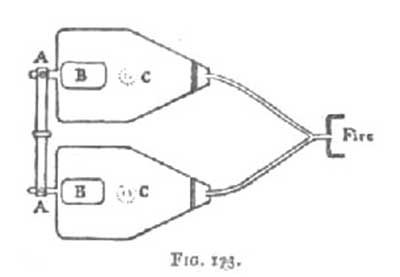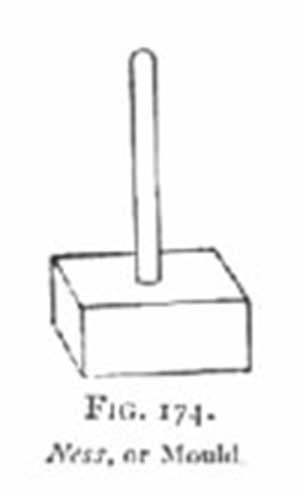The Blacksmith and His Forge in Ancient Ireland
From A Smaller Social History of Ancient Ireland 1906
« previous page | contents | start of chapter | next page »
CHAPTER XX....continued
4. The Blacksmith and his Forge.
In a state of society when war was regarded as the most noble of all professions, and before the invention of gunpowder, those who manufactured swords and spears were naturally looked upon as very important personages. In Ireland they were held in great estimation; and in the historical and legendary tales, we find smiths entertaining kings, princes, and chiefs, and entertained by them in turn. We know that Vulcan was a Grecian god; and the ancient Irish had their smith-god also, the Dedannan, Goibniu, who figures in many of the old romances.
Cérdcha [cairda] originally meant a workshop in general; but its most usual application was to a forge: and it is still so applied, and pronounced cartha (the first syll. long, as in star). A forge was in old times regarded as one of the important centres of a district. If, for instance, horses whose owners were not known were impounded for trespass, notice had to be sent to the dun or fortress of the nearest lord, to the principal church, to the fort of the brehon of the place, and to the forge of the smith: and in like manner notice of a waif should be sent to seven leading persons, among them the chief smith of the district. For forges were places well frequented, as they are at the present day, partly by those who came to get work done, and partly by idlers.
The anvil (inneoin, pron. innone), which was large and heavy, and shaped something like that now in use, with a long projecting snout on the side, was placed on a block or stock, called cepp [kep]. The smith held the red-hot iron in a tennchair [tinneher], pincers or tongs, using his own hand-hammer, while a sledger—if needed—struck with a heavy ord or sledge, as we see at the present day.
A water-trough was kept in the forge, commonly called umar. The smith kept a supply of wood-charcoal in bags, called cual crainn, i.e. 'coal of wood.' I do not know if coal from the mine was used: but the distinctive term cual crainn would seem to imply that it was: and besides, very ancient coal mines have been found near Ballycastle in Antrim. The smith wore an apron commonly of buckskin, like those smiths wear now.
The Irish name for a smith's bellows is builgg [bullig], which is merely the plural form of bolg, a bag, like the English bellows ('bags'); indicating that, in Ireland as in other countries, the primitive bellows consisted of at least two bags, which of course were made of leather. Why two bags were used is obvious—in order to keep up a continuous blast; each being kept blowing in turn while the other was filling. This word builgg the Irish continued to employ for their bellows, even in its most improved form, just as we now call the instruments we have in use 'bellows,' though this word originally meant 'bags,' like the Irish builgg.
From several passages in old Irish literature we are in a measure enabled to reconstruct the old Irish smith's bellows, and exhibit the mode of working it. In the flag standing at the back of the fire was a small hole through which the pipe directed the air-current from the bellows. The name given to the bellows in Cormac's Glossary—di bolg, 'two bags'—indicates that the bellows in view here had two separate chambers lying side by side. Each of these must have consisted of an upper and an under board with sides of leather: and in the under board of each was a simple clapper-valve as in our present kitchen-bellows.
FIG. 173. Conjectural plan of double or two-chambered forge-bellows The bellows blower stood with his feet on BB, facing fire. AA, the cross beam, turn ing on its centre. CC, clapper valves in bottom boards. The rest of the diagram explains itself.
From each chamber extended a pipe, the two pipes uniting into one which was inserted into the hole in the flagstone. The two chambers were placed close to each other, and there must have been a short cross-beam or lever (AA in fig. 173) turning on a centre pivot, with its two ends loosely fastened to the two backward projections of the upper boards. In every forge there was a special bellows-blower, who blew strongly or gently as occasion required, sometimes directed by the smith. The bellows was worked by the naked feet. The bellows-blower stood on top, one foot on each board (at BB), and pressed the two down alternately. As each was pressed down, and its chamber emptied through the pipe, the other was drawn up by its own end of the cross-beam, and the chamber was filled through the clapper-valve at bottom: and thus the chambers were compressed and expanded in turn so as to keep up a continuous blast. There was a cross-bar fixed firmly above the bellows for the blower to grasp with his hands, so as to steady him and enable him to thrust downwards with his feet when a strong blast was required, like a modern bicyclist when mounting a hill.
The bellows used in private houses was totally different in make and mode of using from the forge-bellows, as well as from our present common kitchen-bellows. It was one of those made to blow by revolving fans inside: and it was made of wood, with leather if needed. Accordingly it was called—not builgg—but séidire [shaidera], i.e. 'blower.' All this we infer from the accurate description given in the Laws. This form of bellows is still occasionally met with, but the body is now made of lacquered tin instead of wood and leather.
The last of the smith's appliances to be noticed is the furnace: and the old Irish authorities enable us to reconstruct this as well as the bellows. At the back of the fire was an upright flag with a little hole for the bellows-pipe. The other three sides, which enclosed and confined the fire, were made of clay specially prepared. When they got burned or worn out they were cleared away and replaced by a new structure. For this purpose a mould was used, with an upright handle like that shown here (fig. 174). The mould was set in its place, and the soft moist clay was worked round three of its sides into proper form with the hands, which was done in a few minutes. Then the mould was carefully lifted up, leaving the new furnace ready for use. The smith always kept a supply of the prepared furnace-clay in bags in his forge.
FIG. 174. Ness, or mould.
It was necessary to enclose the fire by a furnace; for the fuel in those days was of wood charcoal, which being lighter than our coal, would, if unconfined, be blown about and scattered by the blast of the bellows.


